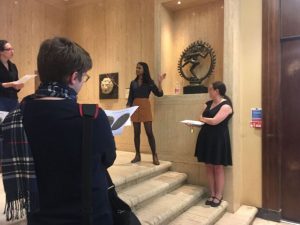
Participating in the lightning talks project with the Barber Institute was one of my favourite experiences this year. The project offered a small group of CAHA students the opportunity to spend three weeks working closely with the Barber’s collection and the curators to research and develop a gallery talk. Having received an email about this early in the term, I was very keen to get on board as I have always been a great fan of the Barber’s collection and was interested in creating a relationship with this collection. I felt that the best way to do this was by not only researching items but then presenting my findings in an engaging manner to the visitors.
During the first stages of the project, I hit an obstacle as I was struggling to choose between a coin that was not on display and a Persepolis wall relief that is often overlooked by visitors.

Kushan coin from the 2nd Century AD in modern day India

Persepolis relief. This image is not from the Barber but a similar one from the British Museum.
This is because both objects appealed to my interests in bringing underappreciated aspects of Eastern history into the limelight. Thankfully, by talking about the different objects and their archival information, with coin curator Dr Maria Vrij, I was able to come to a decision to explore the religious iconography on a Kushan coin, alongside the Lord Shiva statue that is in the foyer of the Barber.

Lord Shiva statue
Having finally come up with item choices, I was able to begin my research process. At first, this meant simply trying to understand the context of the Kushan empire. Following this, I began to form my own responses to the iconography on the coin in relation to the imagery of the Shiva statue. However, this process was more difficult than I expected because the time period and the region is a relatively under-researched one and therefore it took time and care to find very specific views of the coin and the icons it presented. Nevertheless, as I had connected with the items and was very passionate about presenting their stories to people, I could find ways around gaps in my research. So, I moved onto writing up what I wanted to say. By this point, I found that it helped to be able to talk to my friends and family about my research in order to write my talk with an engaging angle.
This project was particularly useful because whilst we were beginning to think about the contents of the talks, we were provided with a short session with Jen Ridding (Head of Public Engagement at the Barber) to explore the planning and structuring of gallery talks. The session included a demonstration from Jen herself and then feedback on our own drafts to get an idea of how we may want to sound to our visitors. This was very beneficial as we saw how an experienced speaker presented artworks and was able to apply that to our own work alongside peers.

Talk on Magritte’s ‘Flavour of Tears’
On the day of the lightning talks, I found that continuous practice with my chosen items was the key method for fighting nerves. Having the chance to spend time in the gallery itself was valuable for this and it helped me to build a relationship with my chosen items alongside the Barber collections as well. I also found that the visitors themselves were a motivator in doing the best gallery talk possible. Seeing them enter the Barber and enjoying the refreshments whilst discussing their interests regarding the Barber drove me to provide my prepared information in a more accessible and personal manner.
Overall, the lightning talks taught me a lot about my relationship with my subject and what I am interested in – in terms of how cultures have found each other in history. More importantly, however, I learnt how to research and present information in a short amount of time. The time constraint meant that we as a group were required to motivate ourselves to not only provide the best experience for the Barber’s visitors but do justice to the objects we were presenting. I would highly recommend this project either to deliver a talk or to attend the talks as a visitor. Both manners of engagement in the project are valuable to anyone with a passion for art or history.
